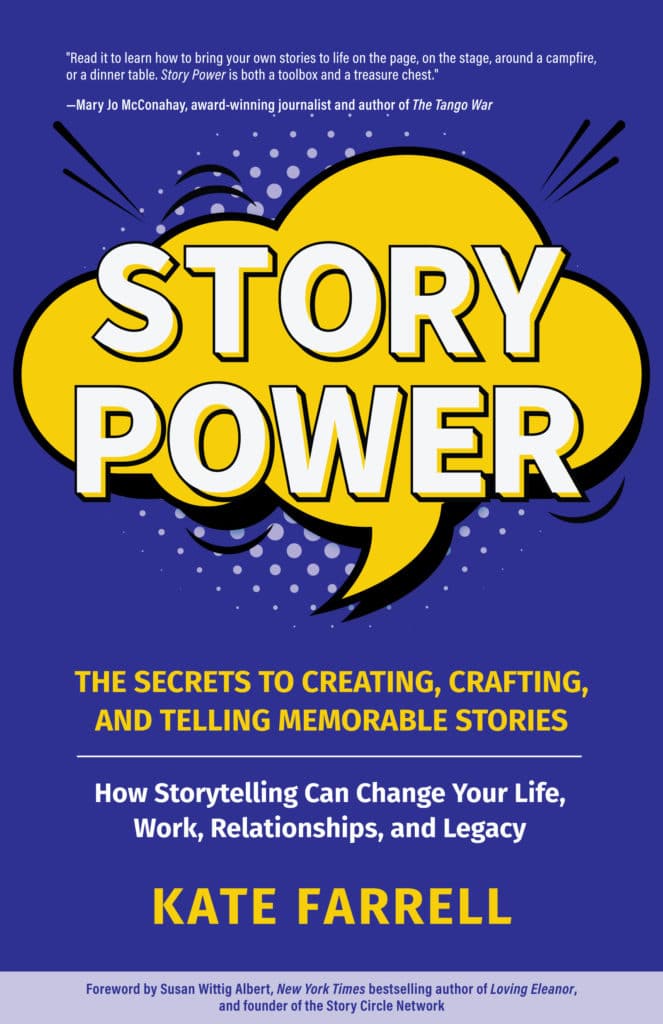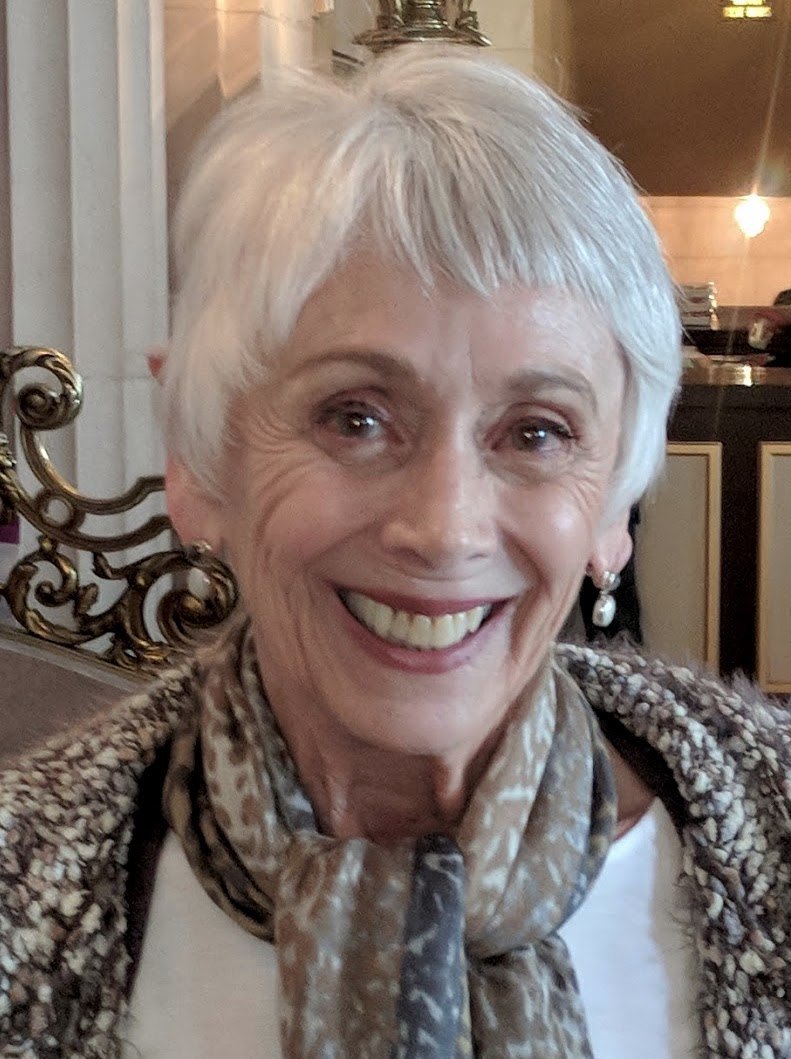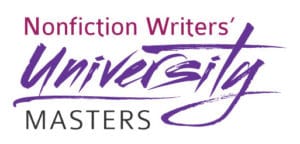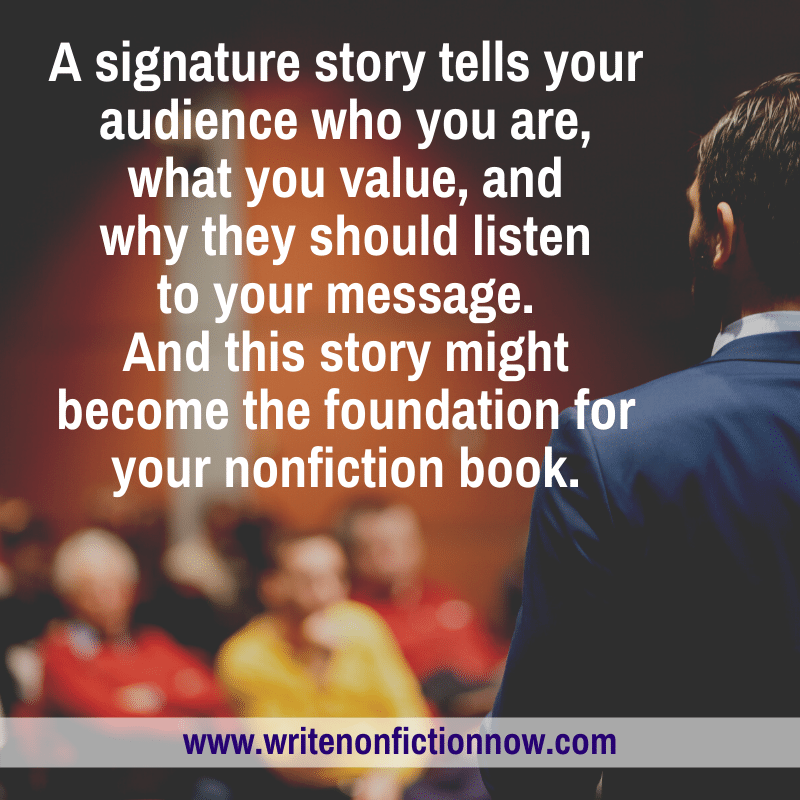Nonfiction writers need signature stories. You’ll use yours for a variety of marketing purposes, including in speeches, articles, blog posts, and videos. This one story tells your audience who you are, what you value, and why they should be interested in your message. It’s the foundation of your branding and, potentially, your nonfiction book.
First made popular by Toastmasters International, signature stories continue to evolve in mainstream culture. Sometimes called the elevator speech, a signature story is a short, well-crafted pitch that introduces you professionally or personally. It is certainly an essential tool for self-marketing. Even though it is a short presentation and often delivered one-on-one in a conversational manner, it must be prepared with as much care as you would a major keynote address. (In fact, signature stories often are extended for use in speeches and can take 30 minutes or more to deliver.)
The basic signature story elements can be structured as a simple, outlined script. If you do this, you can adapt the content for a variety of situations.
How to Find Your Signature Story
A professional signature story is simple to define and easy enough to format. But how do you arrive at the content?
One way is to recall your most successful experience in a given profession or how you overcame a challenge in your work or life. What was your breakthrough moment? Is it motivating enough to share?
Signature stories highlight the best of your professional experience. They help define what makes you successful as well as what gives you joy and your career meaning.
Your Signature Story Focus
The professional signature story is targeted to your career and its goals. Specifically, it focused on breakthrough moments in your vocation or avocation and built on powerful insights you are motivated to share and use to help market and sell products and services.
Signature Story Elements
A signature story should be a complete narrative with its outcome clearly stated. For this story to hold your listeners’ attention and have a lasting impact on them, it needs to include the entire compliments of an unforgettable tale:
- Setting: Where did it take place—in what professional setting?
- Conflict: What was the essential problem or crisis, disagreement, or challenge?
- Action: What are the scenes in the story and the rising action?
- Character: Who are the real-life characters?
- Dialogue: What are the characters saying?
- Breakthrough: What is the breakthrough moment or the resolution?
- Hook: What is the introduction to the story?
The First Sentence
The first sentence of your signature story is the most important. It’s the hook and might very well contain the entire signature speech in a condensed version.
 Introduce yourself as a solution to a problem, one faced by your colleagues in your target market. Job titles and resume-type information are not appropriate in a signature story. Your clients are only interested in how you can help them in their personal or professional life.
Introduce yourself as a solution to a problem, one faced by your colleagues in your target market. Job titles and resume-type information are not appropriate in a signature story. Your clients are only interested in how you can help them in their personal or professional life.
The first sentence gets to the point in plain terms to engage your listeners and tweak their interest. For example, a life coach might introduce herself by saying, “I coach people on how to open closed doors.”
The central element is a personal anecdote that describes your motivation, your aha moment (as related to the field or subject), or an example that demonstrates your expertise. This story lies at the heart of the pitch and is how you create a bond with your listeners. The more compelling the story, the more unforgettable it will be.
No matter how short, this story is still a complete narrative with specific details, vivid language, dialogue, and a clear story structure. The entire signature story, hook, and narrative, takes no more than two to three minutes to tell.
Keep a few signature stories on hand for different audiences—a networking event, blog post, or the back story in a talk.
Signature Story Example
The following signature story is one I’ve told countless times at the beginning of storytelling training sessions, in talks on the power of storytelling, and as a pitch to foundation executives and to influential publishers. This story has been an unqualified success in opening doors. More importantly, it gave me the opportunity to share what I’d learned with many thousands of educators and writers in my field.
“San Francisco Junior High School, 1967”
I stood behind the lectern, my place of refuge, and looked out at my ninth-grade students crammed into every desk in the bleak, overcrowded, urban classroom. It was the dreaded period right after lunch, on a hot, spring day, and I was to teach them English. I’d already realized in this, my first year of teaching, that most of my students could not read or write at grade level, if at all.
My immediate solution had been, “Well, if they can’t read the literature, I’ll read it for them.” Over the months, I’d read aloud from the assigned, grade-level texts: Arabian Nights, Old Yeller, Great Expectations, and Greek mythology. Gripping the rickety, plywood lectern, I’d held sway over my classes with dramatic interpretations.
On that day, I’d prepared to read aloud a Greek myth. Irked at the tired, textbook prose, I realized I couldn’t bear to read another myth from that boring book. I stepped away from the lectern. I stood in front of the class. The class looked at me with some apprehension—I don’t think they’d seen my legs before. I began to tell them, in my own words, the tale that was next in the book, the story of Daphne and Apollo.
I will never forget the change in the room: Suddenly there was nothing else in it except my words and the students’ eyes, watching. They were looking at me with the greatest attention I’d ever received, but at the same time, I knew they were not seeing me at all. They were seeing beyond me, into the myth. In fact, both the students and I were watching the adventure of Daphne and Apollo as it took place.
The classroom itself was transformed. It seemed to become the far-off Greek forest of long ago, with tangled green foliage and splashing streams. For the length of the story, we were there. It was electrifying! And I was no longer bored. No, I was never to forget that day’s experience. I became a storyteller to teach inner-city students literature.
Signature Story Delivery
When I tell this story, I start at the brink of the action on that fateful day and depict the problem: teaching English literature to ninth-grade students who could barely read or write. Even though I’ve told this signature story countless times, its key details trigger my memory once again.
It’s important to note the time of day and season, the overcrowded classroom, the feel of the plywood lectern—even the titles of the books I’d read aloud that year. Most important is the name of the exact myth, the story of Daphne and Apollo. Each essential story element places me at that precise time and place, so I can stand in the middle of the experience and observe it unfold.
The story itself is elastic; it can take thirty seconds or up to three minutes to tell, depending on the situation. But there are specific details to bear in mind and retain—conflict, rising action, resolution.
One element of the story is the hook: I became a storyteller to teach inner-city students literature. This summary statement can be told at the beginning or the end of the story. Either way, it’s a tribute to the power of storytelling to connect in difficult circumstances.
Professional Signature Story Prompts
Answer these prompts to find or create a professional signature story. If you have a few career tracks, fix in your mind one profession. Each career path will have its own signature story, its breakthrough narrative.
Look back on your years in a given profession:
- What was your motivation?
- What are your strengths and weaknesses in the field?
- Who are your role models or mentors?
- What are your greatest career successes?
- What high achievement that you could describe?
- What problem did you solve that you’d like to share?
- What was your aha moment?
- Was it a sudden revelation or did it occur over time?
Personal Signature Story Prompts
Answer these prompts to find or create a personal signature story, one that reflects the best of you, what’s important to you, and who you are:
Look back on your life or the last year or decade:
- What experiences gave you the most happiness or meaning?
- What people do you remember the most?
- What interactions represented the best in your relationships?
- What events demonstrated your truest instincts?
- What situations gave you joy, relief, pride, admiration, or a big insight?
- In what personal setting(s) do you feel the most content?
- When did you feel closest to a personal truth?
- How have you shared your personal story or how could you?
The Value of Signature Storytelling
Signature storytelling is a wonderful skill. According to David Asker, author of Creating Signature Stories, professional signature stories have great value for your personal life as well. He writes, “Finding such stories can help you discover a purpose, set priorities, gain confidence, develop new directions, enhance relationships, engage in a program to gain strengths, and more.”
Use your signature story as an opportunity to reflect on your professional work and the contributions you might not yet have acknowledged. You will benefit from this practice, as will your clients, readers, and social networking circle.
Plus, your signature story provides a powerful motivator for creating a career as a successful author. It may form the crux of your branding, promotion, and even the central message in your nonfiction books.
About the Author
 Kate Farrell, storyteller, author, librarian, founded the Word Weaving Storytelling Project and published numerous educational materials on storytelling. She has contributed to and edited award-winning anthologies of personal narrative. Farrell recently completed a how-to guide on the art of storytelling for adults, Story Power: Secrets to Creating, Crafting, and Telling Memorable Stories, released by Mango Publishing June 2020. Farrell is past president of Women’s National Book Association, San Francisco Chapter. katefarrell.net
Kate Farrell, storyteller, author, librarian, founded the Word Weaving Storytelling Project and published numerous educational materials on storytelling. She has contributed to and edited award-winning anthologies of personal narrative. Farrell recently completed a how-to guide on the art of storytelling for adults, Story Power: Secrets to Creating, Crafting, and Telling Memorable Stories, released by Mango Publishing June 2020. Farrell is past president of Women’s National Book Association, San Francisco Chapter. katefarrell.net
 Would you like to learn more about becoming a nonfiction author? If you aren’t sure how to get started or to move forward on your nonfiction writing journey, check out the Nonfiction Writers’ University MASTERS program. Learn all the steps to becoming a successful—and profitable—author. Discover how (finally) to write consistently, boldly, enthusiastically, and productively. Develop the mindsets, strategies, habits of the world’s most successful writers. Make your difference today. Click here to learn more. (And if you aren’t ready for the Nonfiction Writers’ University Masters program, explore the Nonfiction Writers’ University. You can enjoy a 30-day trial membership for only $1.)
Would you like to learn more about becoming a nonfiction author? If you aren’t sure how to get started or to move forward on your nonfiction writing journey, check out the Nonfiction Writers’ University MASTERS program. Learn all the steps to becoming a successful—and profitable—author. Discover how (finally) to write consistently, boldly, enthusiastically, and productively. Develop the mindsets, strategies, habits of the world’s most successful writers. Make your difference today. Click here to learn more. (And if you aren’t ready for the Nonfiction Writers’ University Masters program, explore the Nonfiction Writers’ University. You can enjoy a 30-day trial membership for only $1.)